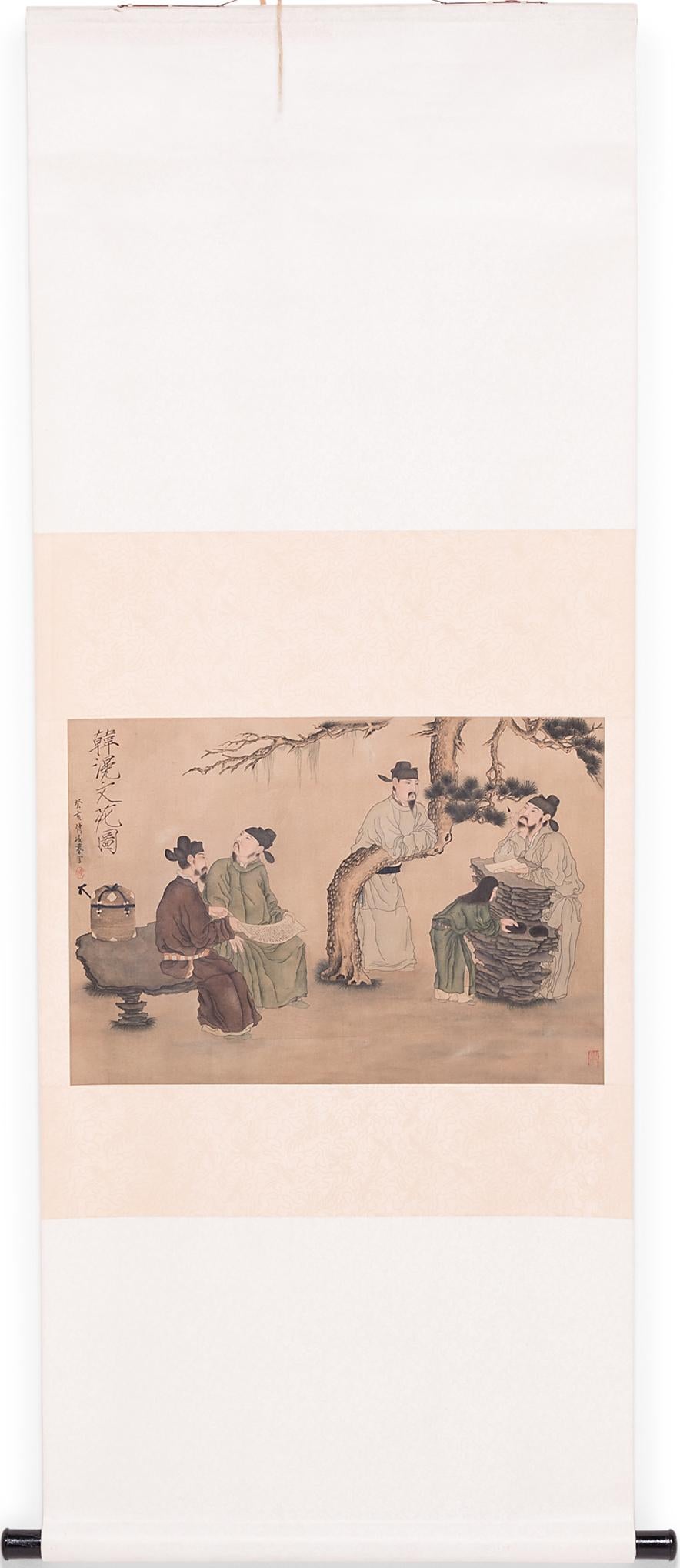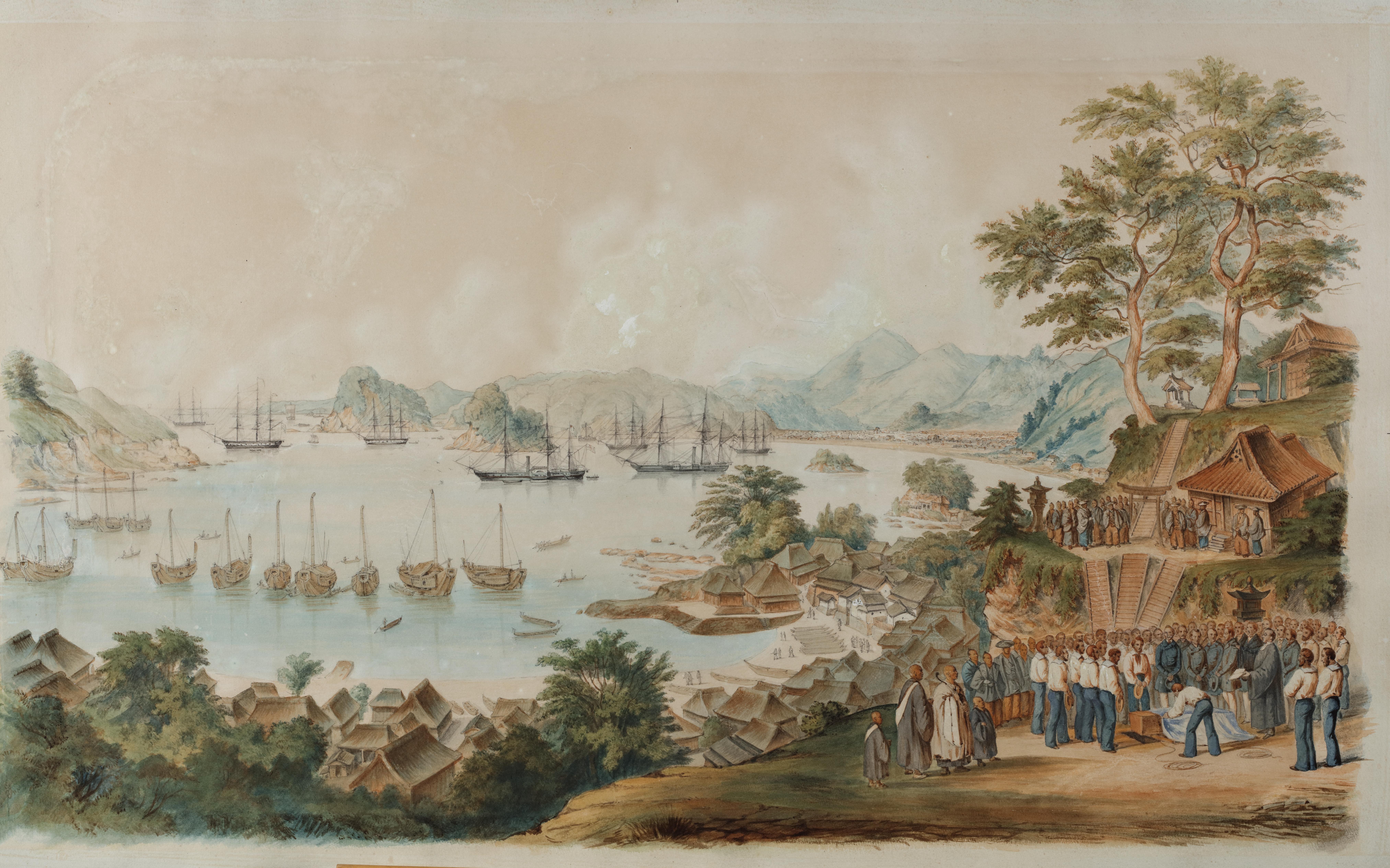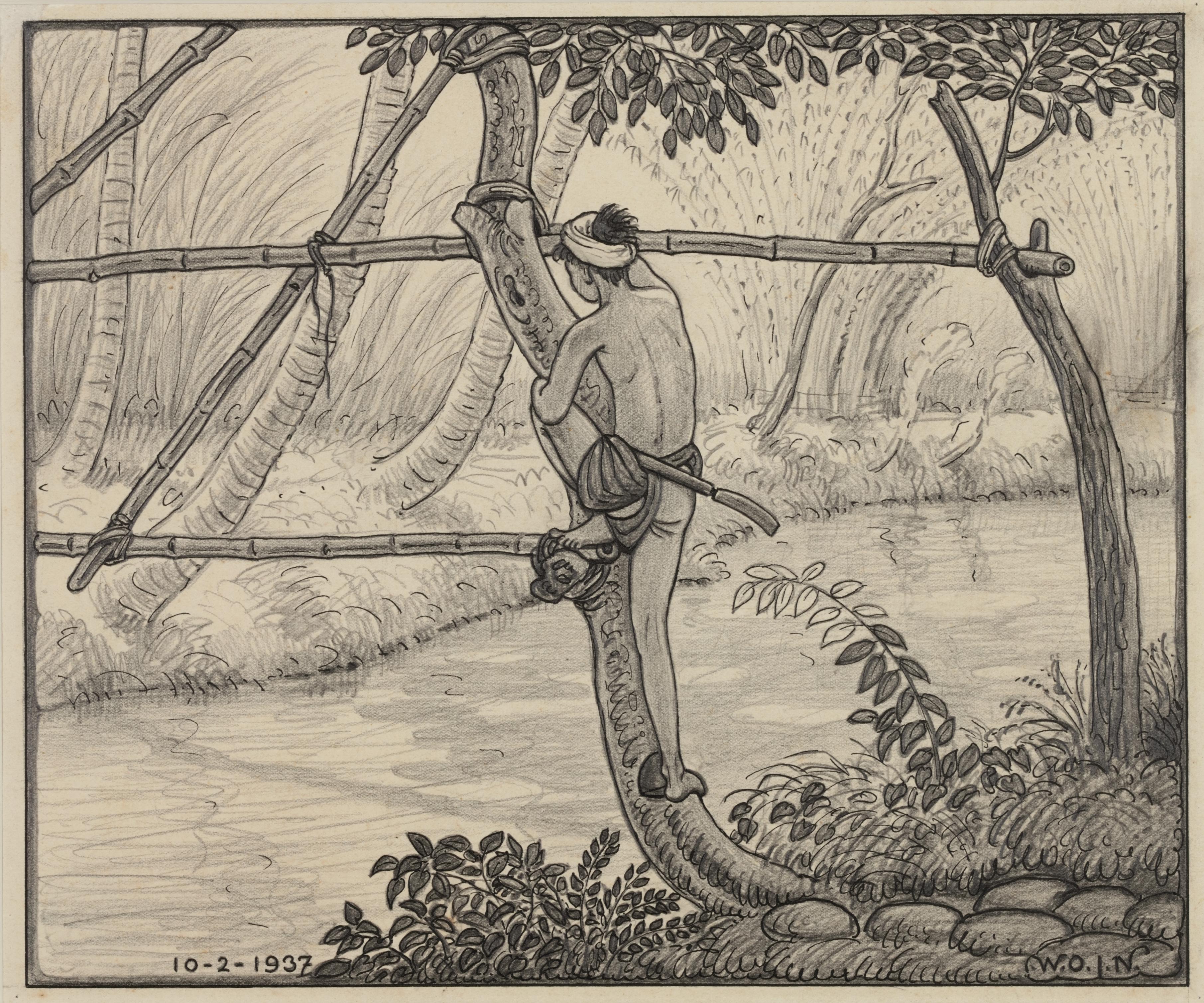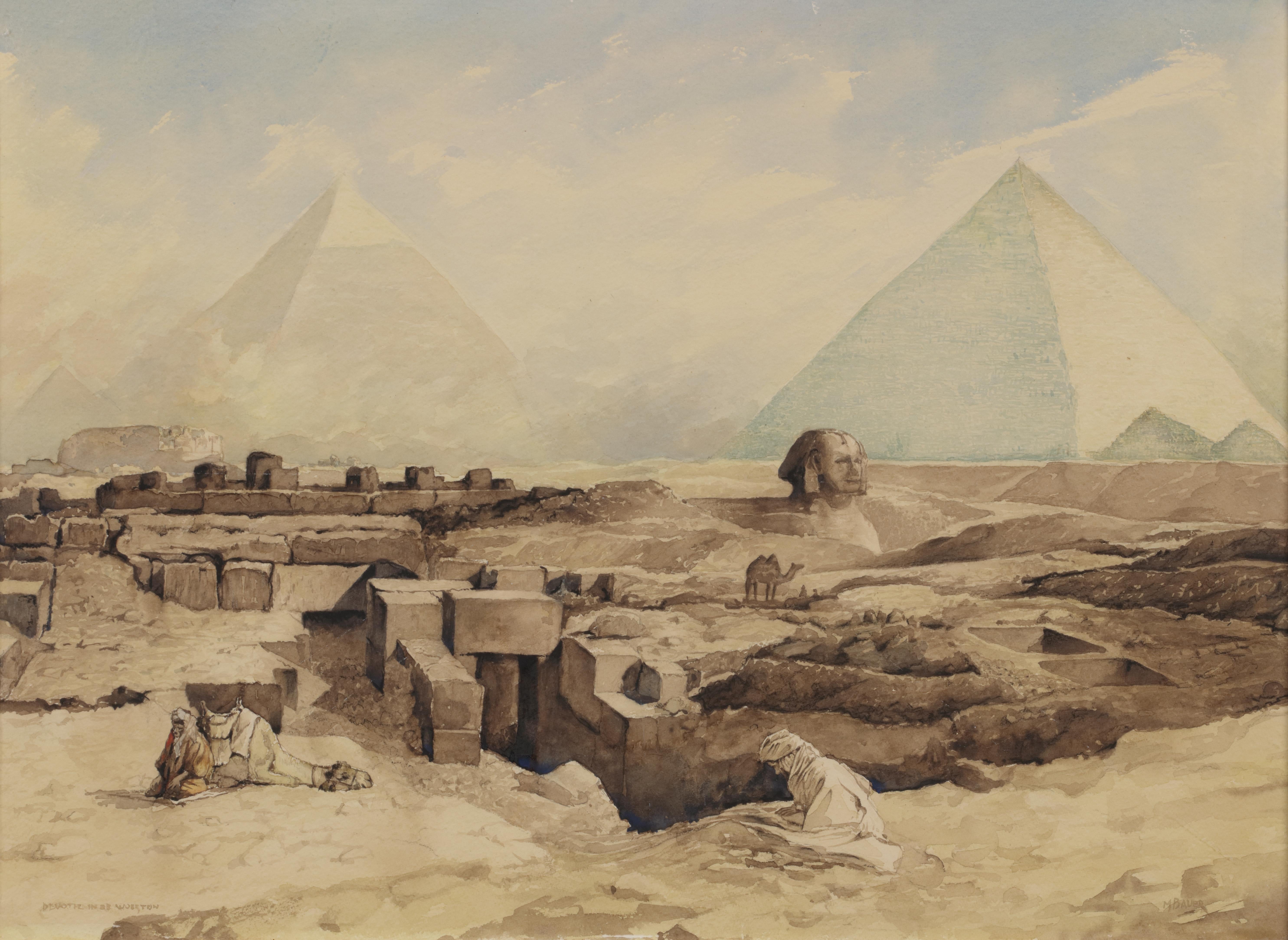Items Similar to "Hanging Scroll of Prunus Branches, " Ink on Paper, 1850
Want more images or videos?
Request additional images or videos from the seller
1 of 8
"Hanging Scroll of Prunus Branches, " Ink on Paper, 1850c. 1850
c. 1850
About the Item
Chinese scholars used natural imagery and scenery to aid in contemplation within the walls of their studios. The complex beauty inherent to landscapes and natural forms inspired clear and concise thinking. It's this emphasis on natural imagery that led to the genre of plum blossom (momei) hanging scrolls. Guided by the gestural extensions of the calligraphic branches, the artist of this painting followed broad initial brushstrokes with delicately painted stems and flowers to create a carefully balanced composition.
This scroll is a 19th-century copy of a painting by calligraphy master Tong Yu (AD 1721–1782).
- Creation Year:c. 1850
- Dimensions:Height: 76 in (193.04 cm)Width: 22 in (55.88 cm)Depth: 1 in (2.54 cm)
- Medium:
- Movement & Style:
- After:Tong Yu (1721 - 1782, Chinese)
- Period:
- Condition:
- Gallery Location:Chicago, IL
- Reference Number:
About the Seller
5.0
Diamond Seller
These expertly vetted sellers are 1stDibs' most experienced sellers and are rated highest by our customers.
1stDibs seller since 2018
25 sales on 1stDibs
- ShippingRetrieving quote...Ships From: Chicago, IL
- Return PolicyA return for this item may be initiated within 2 days of delivery.
More From This SellerView All
- "Literary Garden, " Scroll Painting, 1923Located in Chicago, ILExquisitely painted with delicate line work and a subdued color palette, this Chinese scroll painting is an early 20th century reproduction of a famous...Category
Early 20th Century Qing Figurative Drawings and Watercolors
MaterialsSilk, Paper, Ink
- Japanese Riverside Landscape Scroll, c. 1900Located in Chicago, ILAlthough Western painting was initially embraced during Japan’s Meiji period (1868–1912), artists brought on a revival of traditional painting styles as they sought to create a moder...Category
Early 20th Century Landscape Drawings and Watercolors
MaterialsSilk, Paper, Ink
- Chinese Erotic Album Leaf, c. 1850Located in Chicago, ILDespite its explicit content, this intimate scene conveys a sense of tenderness and romantic love characteristic of Chinese erotic art. Known as “spring palace paintings,” these ink and watercolor illustrations imagined the sensual delights of courtly life. Taken from an album of erotic paintings, this framed leaf departs from a tradition of depicting lovers in risqué outdoor settings by picturing an amorous coupling in a distinctly Qing-dynasty interior. The uniquely detailed surroundings shed light on the prevailing aesthetic tastes in decor and furniture of 19th-century China. Note the carved wooden headrest, blue and white censer...Category
Mid-19th Century Qing Figurative Drawings and Watercolors
MaterialsPaper, Ink, Watercolor
- Chinese Erotic Album Leaf, c. 1850Located in Chicago, ILDespite its explicit content, this intimate scene conveys a sense of tenderness and romantic love characteristic of Chinese erotic art. Known as “sp...Category
Mid-19th Century Qing Figurative Drawings and Watercolors
MaterialsPaper, Ink, Watercolor
- Chinese Erotic Album Leaf, c. 1850Located in Chicago, ILDespite its explicit content, this intimate scene conveys a sense of tenderness and romantic love characteristic of Chinese erotic art. Known as “sp...Category
Mid-19th Century Qing Figurative Drawings and Watercolors
MaterialsPaper, Ink, Watercolor
- Chinese Erotic Album Leaf, c. 1850Located in Chicago, ILDespite its explicit content, this intimate scene conveys a sense of tenderness and romantic love characteristic of Chinese erotic art. Known as “sp...Category
Mid-19th Century Qing Figurative Drawings and Watercolors
MaterialsPaper, Ink, Watercolor
You May Also Like
- 1854 Funeral of R. Williams at Gyokusen-ji Temple, Shimoda, with Commodore PerryLocated in Amsterdam, NLWilhelm Heine (Dresden 30 January 1827-Löbnitz 5 October 1885) ‘Funeral of Robert Williams in the cemetery of the Temple Gyokusen-ji at Shimoda in April 1854’ With a sticker on the reverse of the frame by Coupil & Co. 1855 Watercolour on paper, H. 57 x W. 92 cm Depicted is the Bay of Shimoda with seven American ships including the two paddle-wheel warships USS Mississippi and Susquehanna. On the Gyokus- en-ji temple grounds on the right is the coffin in the middle with the remains of US marine Robert Williams, ready to be lowered into the grave. Looking on from the left are the Buddhist monks and Japanese officials who joined the first Christian funeral on Japanese soil. Around the grave are US marines, Commodore Perry...Category
Mid-19th Century Figurative Drawings and Watercolors
MaterialsPaper, Ink, Watercolor, Gouache
- Statue of Vishnu Garuda, Bali, 1904Located in Amsterdam, NLStatue of Vishnu Garuda, Bali, 1904 Signed with initials Pencil and ink on paper, 21.4 x 21.3 cm Literature: Bruce W. Carpenter, W.O.J. Nieuwenkamp. First European Artist in Bali,...Category
Early 1900s Art Nouveau Landscape Drawings and Watercolors
MaterialsPaper, Pencil, India Ink
- Beach of Kusambe, Bali 1937Located in Amsterdam, NLFour outrigger proa’s on the beach of Kusambe, Bali, 1937 Signed with initials, dated and described with location bottom left Pencil and ink on paper, 29.7 x 35 cm In ebonized frame with white mount WILLEM OTTO WIJNAND NIEUWENKAMP (1874-1950) Nieuwenkamp was born on July 27th 1874 in Amsterdam. His father owned sailing ships sailing to Indonesia and hearing the stories of the returning captains evoked in the young Nieuwenkamp an obsession for distant lands and adventure. After a failed attempt by his father to have his son make a career in his business, Nieuwenkamp attended the Academy for Decorative Art in Amsterdam. However, he left within one year to go his own way. He was an autodidact and a great experimenter with new techniques, particularly in the art of etching. Nieuwenkamp was a very focused man with the discipline of a scientist tempered by the sensitivity of an artist, a lust for adventure, a natural appreciation for ethnic arts and an enormous ambition to tread new paths. In 1898 he visited Indonesia for the first time and on his second visit in 1903-1904 he went on to Bali and became the first foreign artist to love Bali and the Balinese with a passion. Having secured agreements with several museums in the Netherlands to obtain Balinese art and objects for their collections, Nieuwenkamp immediately started to purchase and order a wide range of ethnographic art and objects from local artists and craftsmen. Through his drawings and books, he gave an excellent impression of Balinese art and culture at that time. Since 1854 Northern Bali was under Dutch...Category
1930s Art Nouveau Landscape Drawings and Watercolors
MaterialsPaper, India Ink, Pencil
- Borobudur, Java, Indonesia (1937)Located in Amsterdam, NLGraveyard with in the background the Borobudur, 1937 Signed with initials and dated bottom left Pencil and ink on paper, 33 x 29 cm In ebonized frame with white mount Literature: ...Category
1930s Art Nouveau Landscape Drawings and Watercolors
MaterialsPaper, Ink, Graphite
- Wobbly bridge, Tabanan, Bali, 1937Located in Amsterdam, NLWobbly bridge, Tabanan, Bali, 1937 Signed with initials bottom right and dated, bottom left Pencil and ink on paper, 22 x 26.3 cm In ebonized frame with white mount Willem Otto Wi...Category
1930s Art Nouveau Landscape Drawings and Watercolors
MaterialsPaper, India Ink, Pencil
- Devotion in the Dessert near the pyramids of Gizeh, circa 1919By Marius BauerLocated in Amsterdam, NLMarius Bauer (1867-1932) ‘Devotie in de Woestijn’ (Devotion in the Dessert near the pyramids of Gizeh, circa 1919) Signed lower right and titled lower left Watercolour on paper, H...Category
Early 20th Century Impressionist Landscape Drawings and Watercolors
MaterialsPaper, Ink, Watercolor, Pencil





